The global 5G remote surgery system market is projected to grow from USD 818.3 million in 2025 to approximately USD 1,371.5 million by 2035, recording an absolute increase of USD 553.2 million over the forecast period. This translates into a total growth of 67.6%, with the market forecast to expand at a compound annual growth rate (CAGR) of 5.3% between 2025 and 2035. The overall market size is expected to grow by nearly 1.7X during the same period, supported by increasing adoption of telemedicine solutions, rising demand for remote healthcare delivery, and growing focus on surgical accessibility in underserved areas.
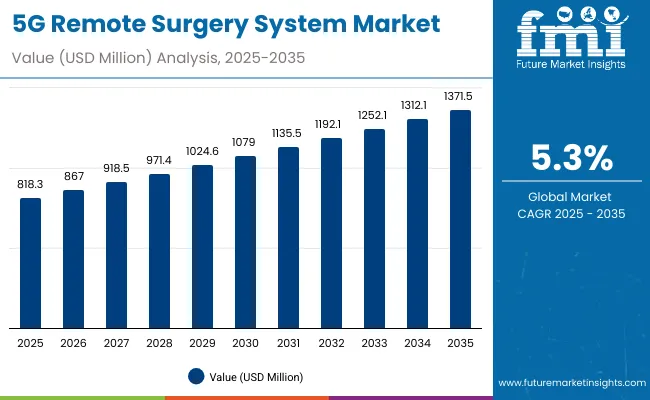
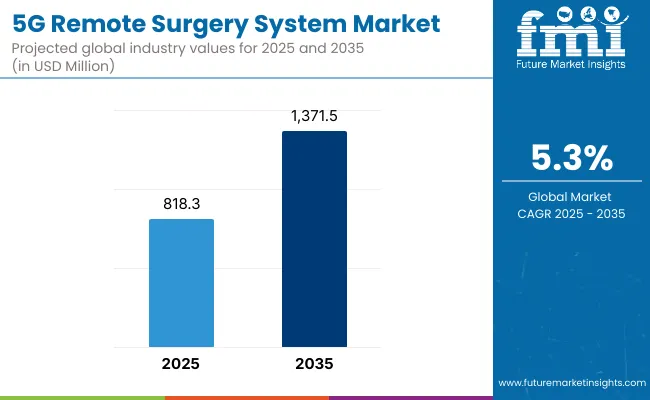
5G Remote Surgery System Market Key Takeaways
| Metric | Value |
|---|---|
| Estimated Value in (2025E) | USD 818.3 million |
| Forecast Value in (2035F) | USD 1,371.5 million |
| Forecast CAGR (2025 to 2035) | 5.3% |
Between 2025 and 2030, the 5G remote surgery system market is projected to expand from USD 818.3 million to USD 1,059.4 million, resulting in a value increase of USD 241.1 million, which represents 43.6% of the total forecast growth for the decade. This phase of growth will be shaped by rising awareness about remote surgical capabilities, increasing demand for specialized surgical access, and growing penetration of 5G technologies in healthcare markets. Healthcare providers are expanding their remote surgery capabilities to address the growing demand for effective surgical solutions in remote and underserved locations.
From 2030 to 2035, the market is forecast to grow from USD 1,059.4 million to USD 1,371.5 million, adding another USD 312.1 million, which constitutes 56.4% of the overall ten-year expansion. This period is expected to be characterized by expansion of specialized surgical centers, integration of advanced 5G networks with surgical platforms, and development of personalized remote surgical protocols. The growing adoption of evidence-based surgical medicine and healthcare provider recommendations will drive demand for clinically proven 5G remote surgery systems with enhanced precision and safety profiles.
Between 2020 and 2025, the 5G remote surgery system market experienced steady expansion, driven by increasing recognition of healthcare accessibility challenges and growing acceptance of telemedicine approaches. The market developed as healthcare providers recognized the need for remote surgical solutions to address complex procedures in underserved areas. Clinical research and regulatory approvals began emphasizing the importance of 5G technologies in achieving better surgical outcomes for remote patient populations.
Market expansion is being supported by the increasing need for surgical access in remote areas and the corresponding demand for advanced telecommunications-enabled surgical approaches. Modern healthcare providers are increasingly focused on remote surgical technologies that can provide real-time surgical guidance, improve access to specialist care, and reduce the burden of patient travel for complex procedures. The proven efficacy of 5G remote surgery systems in performing complex procedures like cardiac surgery, orthopedic procedures, and minimally invasive surgeries makes them essential components of comprehensive healthcare delivery plans.
The growing emphasis on healthcare equity and precision surgery is driving demand for tailored remote surgical technologies that address individual patient needs and geographical limitations. Healthcare provider preference for high-bandwidth communication solutions that combine multiple surgical modalities in integrated platforms is creating opportunities for innovative system development. The rising influence of clinical guidelines and evidence-based treatment protocols is also contributing to increased adoption of proven 5G remote surgery technologies across different patient populations and surgical specialties.
The market is segmented by product, technology, application, end user, and region. By product, the market is divided into robotic surgical systems, 5G communication infrastructure, telemedicine platforms, and surgical accessories and instruments. Based on technology, the market is categorized into 5G network technology, surgical robotics technology, real-time data transmission, and AI and machine learning. In terms of application, the market is segmented into hepatobiliary surgery, pancreatic surgery, cardiovascular surgery, orthopedic surgery, urological surgery, and tele-surgical training and education. By end user, the market is divided into hospitals and clinics, remote and rural healthcare centers, academic and research institutions, and emergency and mobile healthcare units. Regionally, the market is divided into North America, Europe, East Asia, South Asia & Pacific, Latin America, and Middle East & Africa.
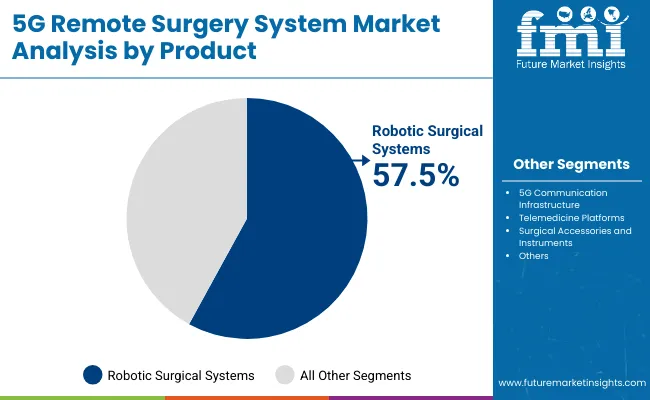
The robotic surgical systems segment is projected to account for 57.5% of the 5G remote surgery system market in 2025, reaffirming its position as the category's dominant product type. Healthcare providers increasingly recognize the critical importance of advanced robotic platforms for performing precise remote surgical procedures with enhanced dexterity and control capabilities. This product type addresses core surgical needs and provides essential technology foundation for remote surgical interventions across various specialties.
This product type forms the foundation of most remote surgical protocols, as it represents the most clinically validated and widely accepted technology platform in telemedicine surgery. Regulatory approvals and extensive clinical research continue to strengthen confidence in these surgical systems. With increasing recognition of the complexity of remote surgery requiring sophisticated robotic capabilities, surgical systems align with both emergency surgical interventions and planned remote procedure goals. Their broad surgical utility across multiple specialties ensures sustained market dominance, making them the central growth driver of 5G remote surgery demand.
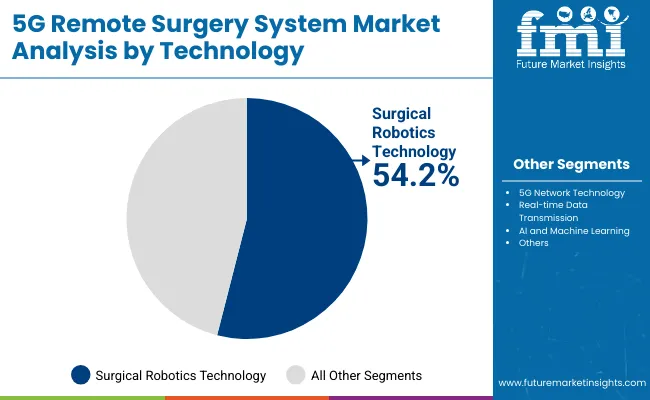
Surgical robotics technology applications are projected to represent 54.2% of 5G remote surgery systems demand in 2025, underscoring their role as the primary technology driving remote surgical adoption. Healthcare providers recognize that complex surgical procedures require sophisticated robotic technologies that traditional remote surgical methods cannot adequately address. Robotic technologies offer enhanced precision in surgical interventions, real-time tactile feedback, and advanced visualization capabilities.
The segment is supported by the critical nature of surgical precision requirements and the growing recognition that robotic approaches can improve surgical outcomes and patient safety. Additionally, healthcare systems are increasingly adopting evidence-based surgical guidelines that recommend specific robotic technologies for optimal remote surgical results. As clinical understanding of remote surgery capabilities advances, surgical robotics technology will continue to play a crucial role in comprehensive telemedicine strategies, reinforcing their essential position within the 5G remote surgery system market.
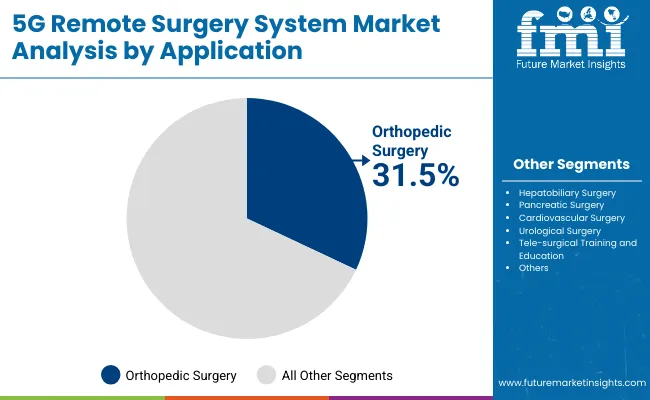
The orthopedic surgery application is forecasted to contribute 31.5% of the 5G remote surgery system market in 2025, reflecting the primary role of musculoskeletal procedures in remote surgical interventions. Patients requiring orthopedic surgical procedures often face geographical barriers to accessing specialized care, making remote surgical capabilities essential for comprehensive treatment delivery. This application provides critical surgical services including joint replacements, fracture repairs, and coordination with rehabilitation protocols.
The segment benefits from established surgical protocols and proven effectiveness in orthopedic procedure delivery. Remote orthopedic surgery also offers advantages in terms of surgeon expertise access, specialized equipment utilization, and patient convenience through reduced travel requirements. With growing emphasis on surgical accessibility and patient-centered care services, orthopedic applications serve as critical use cases for 5G remote surgery systems, making them fundamental drivers of market accessibility and surgical advancement.
The hospitals and clinics channel is forecasted to contribute 64.3% of the 5G remote surgery system market in 2025, reflecting the primary role of medical institutions in advanced surgical services and patient care. Patients requiring complex surgical procedures rely on hospital-based surgical programs for sophisticated remote surgical capabilities, making hospitals the cornerstone of 5G remote surgery system utilization. This channel provides essential services including comprehensive surgical programs, multidisciplinary care teams, and coordination with medical treatment protocols.
The segment benefits from established surgical expertise and comprehensive surgical capabilities that hospitals provide. Medical institutions also offer advantages in terms of clinical research participation, technology integration, and access to specialized surgical professionals. With growing emphasis on comprehensive surgical medicine and patient-centered care services, hospitals serve as critical deployment points for 5G remote surgery systems, making them fundamental drivers of market accessibility and surgical innovation.
The 5G remote surgery system market is advancing steadily due to increasing recognition of healthcare accessibility challenges and growing demand for remote surgical approaches. However, the market faces challenges including complex regulatory pathways, high technology implementation costs, and concerns about surgical quality and safety in remote settings. Innovation in 5G communication technologies and surgical robotics platforms continue to influence product development and market expansion patterns.
Expansion of 5G Network Infrastructure and Telecommunications Capabilities
The growing deployment of 5G network infrastructure is enabling more sophisticated remote surgical delivery and real-time communication. Advanced 5G networks offer comprehensive telecommunications services, including ultra-low latency communication, high-bandwidth data transmission, and reliable connectivity, that are particularly important for complex remote surgical procedures. High-speed communication systems provide access to real-time surgical guidance that can optimize procedure outcomes and surgical safety.
Integration of Artificial Intelligence and Machine Learning Technologies
Modern surgical technology companies are incorporating artificial intelligence technologies such as surgical planning algorithms, real-time procedure analysis systems, and automated surgical guidance to enhance remote surgery capabilities. These technologies improve surgical precision, enable real-time performance assessment, and provide better coordination between remote surgeons and local surgical teams. Advanced AI platforms also enable personalized surgical protocols and early identification of potential complications or procedure optimization opportunities.
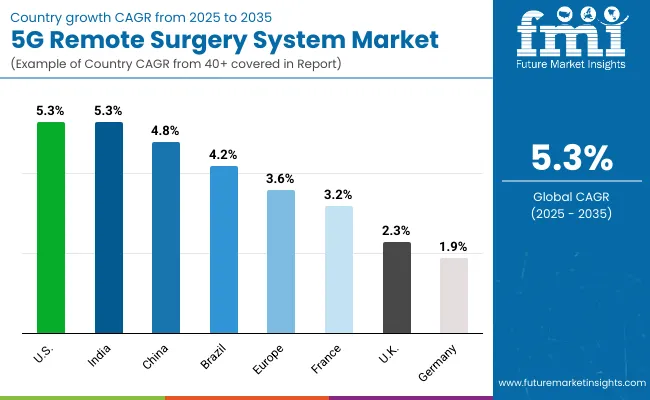
| Country | CAGR (2025 to 2035) |
|---|---|
| USA | 5.3% |
| India | 5.3% |
| China | 4.8% |
| Brazil | 4.2% |
| France | 3.2% |
| UK | 2.3% |
| Germany | 1.9% |
The 5G remote surgery system market is experiencing varied growth globally, with the USA and India both leading at a 5.3% CAGR through 2035, driven by expanding 5G infrastructure, increasing surgical access needs, and growing adoption of telemedicine technologies. China follows at 4.8%, supported by healthcare system modernization, increasing recognition of remote healthcare importance, and expanding surgical technology adoption. Brazil shows growth at 4.2%, emphasizing improved access to specialized surgical services and 5G technology adoption. Europe records 3.6% growth, focusing on evidence-based surgical protocols and comprehensive telemedicine systems. Germany shows 1.9% growth, representing a mature market with established surgical patterns and regulatory frameworks.
The report covers an in-depth analysis of 40+ countries; seven top-performing countries are highlighted below.
Revenue from 5G remote surgery systems in China is projected to exhibit steady growth with a CAGR of 4.8% through 2035, driven by ongoing 5G network expansion and increasing recognition of telemedicine as a priority healthcare solution. The country's expanding telecommunications infrastructure and growing availability of specialized surgical services are creating significant opportunities for remote surgery technology adoption. Major international and domestic technology companies are establishing comprehensive distribution networks to serve the growing population of patients requiring remote surgical access across urban and rural regions.
Revenue from 5G remote surgery systems in India is expanding at a CAGR of 5.3%, supported by increasing 5G accessibility, growing surgical access awareness, and expanding telemedicine market presence. The country's large patient population and increasing recognition of remote healthcare solutions are driving demand for effective remote surgical technologies. International technology companies and domestic manufacturers are establishing distribution channels to serve the growing demand for quality remote surgical capabilities.
Demand for 5G remote surgery systems in the USA is projected to grow at a CAGR of 5.3%, supported by well-established telemedicine systems and evidence-based remote surgical guidelines. American healthcare providers consistently utilize remote surgical technologies for specialty procedure access and rural healthcare delivery. The market is characterized by mature telemedicine protocols, comprehensive insurance coverage, and established relationships between healthcare providers and technology companies.
Revenue from 5G remote surgery systems in Brazil is projected to grow at a CAGR of 4.2% through 2035, driven by healthcare system development, increasing access to specialized surgical services, and growing recognition of telemedicine importance. Brazilian healthcare providers are increasingly adopting remote surgical approaches for complex medical procedures, supported by expanding technology market presence and improved surgical accessibility.
Revenue from 5G remote surgery systems in the UK is projected to grow at a CAGR of 2.3% through 2035, supported by the National Health Service framework and comprehensive evidence-based surgical guidelines that facilitate appropriate use of remote surgical technologies for specialized procedures. British healthcare providers consistently utilize established protocols for remote surgery management, emphasizing patient outcomes and surgical optimization within integrated care systems.
Revenue from 5G remote surgery systems in Germany is projected to grow at a CAGR of 1.9% through 2035, supported by the country's well-established surgical infrastructure, comprehensive healthcare coverage, and systematic approach to telemedicine. German healthcare providers emphasize evidence-based remote surgery utilization within structured healthcare frameworks that prioritize clinical effectiveness and patient safety.
Revenue from 5G remote surgery systems in France is projected to grow at a CAGR of 3.2% through 2035, supported by the country's comprehensive healthcare system, established surgical infrastructure, and systematic approach to telemedicine. French healthcare providers emphasize evidence-based remote surgery utilization within integrated care frameworks that prioritize patient outcomes and surgical continuity.
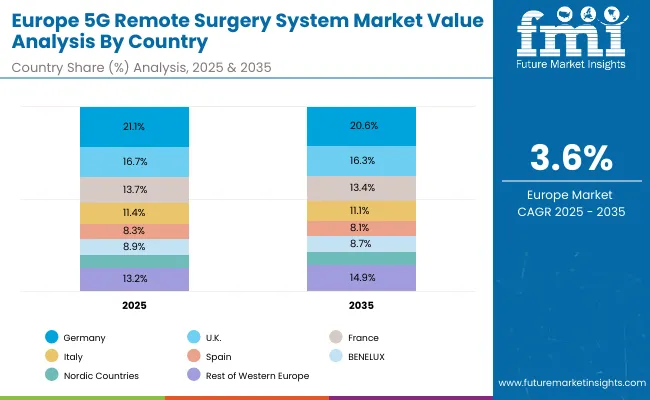
The 5G remote surgery system market in Europe is projected to expand steadily through 2035, supported by increasing adoption of telemedicine technologies, rising need for surgical accessibility, and ongoing clinical innovation in remote surgical systems. Germany will continue to lead the regional market, accounting for 21.1% in 2025 and declining slightly to 20.6% by 2035, supported by a strong clinical research base, reimbursement pathways, and robust surgical infrastructure. The United Kingdom follows with 16.7% in 2025, decreasing to 16.3% by 2035, driven by NHS adoption of advanced surgical guidelines, telemedicine integration, and expanding specialist networks.
France holds 13.7% in 2025, declining to 13.4% by 2035 as other markets expand remote surgery adoption and demand grows for specialized surgical solutions. Italy contributes 11.4% in 2025, decreasing to 11.1% by 2035, supported by regional surgical programs and growing clinical research participation. Spain represents 8.3% in 2025, declining to 8.1% by 2035, underpinned by strengthening access to surgical services and telemedicine programs.
BENELUX markets together account for 8.9% in 2025, moving to 8.7% by 2035, supported by innovation-friendly regulatory frameworks and academic-industry collaboration. The Nordic countries represent 6.9% in 2025, declining to 6.8% by 2035, with demand fueled by progressive healthcare systems and early adoption of evidence-based telemedicine solutions. The Rest of Western Europe increases from 13.2% in 2025 to 14.9% by 2035, as emerging markets capture greater share of investment, clinical trials, and adoption of remote surgical protocols.
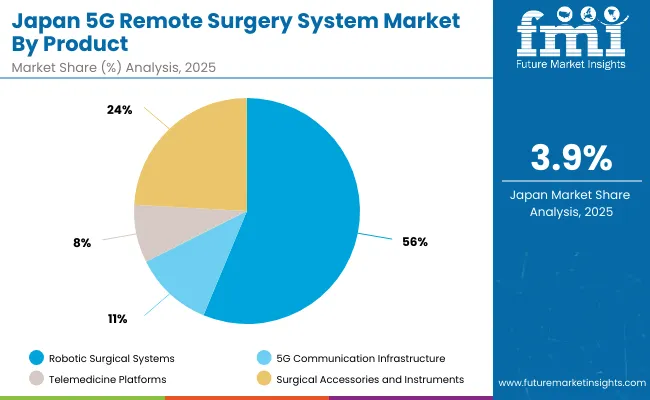
The 5G remote surgery system market in Japan is set to remain diversified across several product categories in 2025, reflecting clinical preferences in surgical practice and evolving telemedicine patterns. Robotic Surgical Systems dominate with a 56.3% share in 2025, supported by their central role in complex surgical procedures, precision surgery requirements, and advanced surgical capabilities within healthcare facilities.
5G Communication Infrastructure represents 11.3% in 2025, gaining importance from network expansion and telecommunications requirements for remote surgical applications. Telemedicine Platforms hold 8.3%, sustained by their widespread integration with surgical workflows and remote consultation capabilities.
Meanwhile, Surgical Accessories and Instruments account for 24.1%, driven by comprehensive surgical support requirements and specialized device needs for remote surgical procedures. This distribution reflects the growing role of integrated surgical systems and advanced telecommunications technologies entering clinical practice in Japanese healthcare systems.
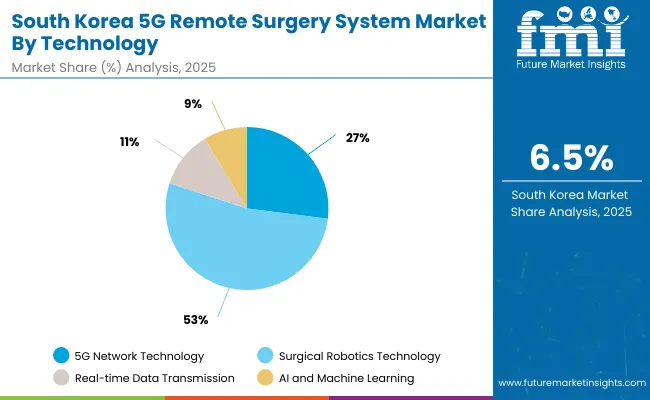
The 5G remote surgery system market in South Korea in 2025 is shaped by strong demand across core technology segments, reflecting both clinical requirements and technological advancement. 5G Network Technology accounts for 27.0% share, supported by the country's advanced telecommunications infrastructure, high-speed connectivity capabilities, and increasing integration of 5G technologies to address remote surgical communication needs.
Surgical Robotics Technology follows with 53.0%, driven by the rising demand for precision surgical solutions, advanced robotic surgery awareness, and wider adoption of sophisticated surgical robotics protocols. Real-time Data Transmission contributes 11.3%, supported by the established need for instant communication systems in surgical applications and growing integration of data transmission technologies with surgical protocols.
AI and Machine Learning represents 8.7%, reflecting the expanding role of artificial intelligence in surgical planning and the integration of machine learning technologies for surgical optimization and decision support systems within South Korea's technologically advanced healthcare system.
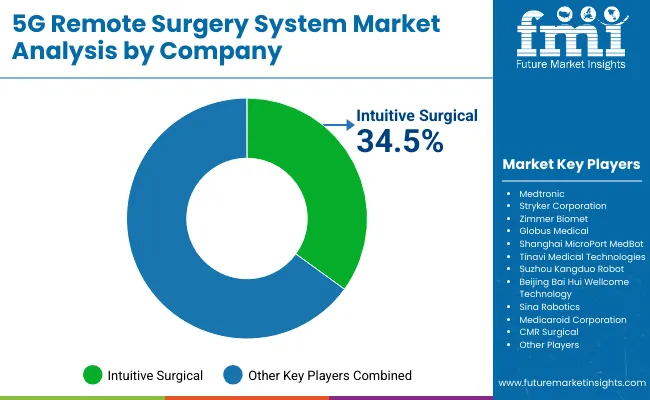
The 5G remote surgery system market is characterized by competition among established medical technology companies, specialized surgical robotics manufacturers, and telecommunications technology focused firms. Companies are investing in 5G integration, surgical robotics innovation, regulatory compliance, and clinical partnerships to deliver effective, safe, and accessible remote surgical solutions. Technology development, clinical validation, and market access strategies are central to strengthening product portfolios and market presence.
Intuitive Surgical leads the market with 34.5% global value share, offering clinically-proven robotic surgical systems with a focus on surgical precision and remote procedure capabilities. Other players collectively account for 65.5% market share, including Medtronic, which provides comprehensive surgical technologies with emphasis on remote surgical integration. Stryker Corporation focuses on innovative surgical robotics and specialized remote surgical platforms. Zimmer Biomet delivers established orthopedic surgical systems with strong clinical evidence and remote surgical capabilities.
Globus Medical operates with focus on bringing innovative surgical technologies to spine and orthopedic remote surgery markets. Shanghai MicroPortMedBot provides comprehensive robotic surgical portfolios including systems across multiple surgical specialties. Tinavi Medical Technologies specializes in orthopedic surgical robotics and specialized remote surgical solutions. Suzhou Kangduo Robot, Beijing BaihuiWellcome Technology, Sina Robotics, Medicaroid Corporation, CMR Surgical, Asensus Surgical, Vicarious Surgical, Siemens Healthineers, and Moon Surgical provide specialized surgical technologies and innovative remote surgical solutions to enhance market accessibility and patient access to essential surgical capabilities.
5G remote surgery systems are emerging as transformative healthcare delivery technologies with strong applications in surgical accessibility, specialist care distribution, emergency interventions, and underserved area healthcare. The market's advantages - ultra-low latency communication, real-time surgical precision, geographic barrier elimination, and specialist expertise distribution - make 5G remote surgery attractive to healthcare systems, telecommunications providers, and patients seeking access to specialized surgical care regardless of location. Scaling 5G remote surgery commercialization requires coordinated action across telecommunications regulators, medical device authorities, network infrastructure providers, surgical institutions, and capital enablers.
| Items | Values |
|---|---|
| Quantitative Units (2025) | USD 818.3 Million |
| Product | Robotic Surgical Systems, 5G Communication Infrastructure, Telemedicine Platforms, Surgical Accessories and Instruments |
| Technology | 5G Network Technology, Surgical Robotics Technology, Real-time Data Transmission, AI and Machine Learning |
| Application | Hepatobiliary Surgery, Pancreatic Surgery, Cardiovascular Surgery, Orthopedic Surgery, Urological Surgery, Tele-surgical Training and Education |
| End User | Hospitals and Clinics, Remote and Rural Healthcare Centers, Academic and Research Institutions, Emergency and Mobile Healthcare Units |
| Regions Covered | North America, Europe, East Asia, South Asia & Pacific, Latin America, Middle East & Africa |
| Countries Covered | United States, Canada, United Kingdom, Germany, France, China, Japan, South Korea, India, Brazil, Australia and 40+ countries |
| Key Companies Profiled | Intuitive Surgical, Medtronic, Stryker Corporation, Zimmer Biomet, Globus Medical, Shanghai MicroPort MedBot , Tinavi Medical Technologies, Suzhou Kangduo Robot, Beijing Baihui Weikang Technology Co., Ltd., Sina Robotics, Medicaroid Corporation, CMR Surgical, Asensus Surgical, Vicarious Surgical , Siemens Healthineers , Moon Surgical |
| Additional Attributes | Dollar sales by product type and surgical application, regional demand trends, competitive landscape, healthcare provider preferences for specific remote surgical technologies, integration with 5G networks, innovations in surgical robotics platforms, patient outcome monitoring, and clinical effectiveness optimization |
By 2035, the 5G remote surgery system market is expected to reach USD 1,371.5 million, growing at a CAGR of 5.3% from its 2025 value of USD 818.3 million.
Robotic surgical systems lead the 5G remote surgery system market, accounting for 57.5% of the market share in 2025.
The 5G remote surgery system market is driven by the expansion of 5G networks, increasing demand for surgical access in remote areas, and growing adoption of robotic surgical platforms for complex procedures.
The USA and India both show the highest CAGR of 5.3% in the 5G remote surgery system market during 2025–2035, followed by China at 4.8%.
Key players in the 5G remote surgery system market include Intuitive Surgical, Medtronic, Stryker Corporation, Zimmer Biomet, Globus Medical, Shanghai Micro Port Med Bot, Tinavi Medical Technologies, and Siemens Healthineers.






Our Research Products

The "Full Research Suite" delivers actionable market intel, deep dives on markets or technologies, so clients act faster, cut risk, and unlock growth.

The Leaderboard benchmarks and ranks top vendors, classifying them as Established Leaders, Leading Challengers, or Disruptors & Challengers.

Locates where complements amplify value and substitutes erode it, forecasting net impact by horizon

We deliver granular, decision-grade intel: market sizing, 5-year forecasts, pricing, adoption, usage, revenue, and operational KPIs—plus competitor tracking, regulation, and value chains—across 60 countries broadly.

Spot the shifts before they hit your P&L. We track inflection points, adoption curves, pricing moves, and ecosystem plays to show where demand is heading, why it is changing, and what to do next across high-growth markets and disruptive tech

Real-time reads of user behavior. We track shifting priorities, perceptions of today’s and next-gen services, and provider experience, then pace how fast tech moves from trial to adoption, blending buyer, consumer, and channel inputs with social signals (#WhySwitch, #UX).

Partner with our analyst team to build a custom report designed around your business priorities. From analysing market trends to assessing competitors or crafting bespoke datasets, we tailor insights to your needs.
Supplier Intelligence
Discovery & Profiling
Capacity & Footprint
Performance & Risk
Compliance & Governance
Commercial Readiness
Who Supplies Whom
Scorecards & Shortlists
Playbooks & Docs
Category Intelligence
Definition & Scope
Demand & Use Cases
Cost Drivers
Market Structure
Supply Chain Map
Trade & Policy
Operating Norms
Deliverables
Buyer Intelligence
Account Basics
Spend & Scope
Procurement Model
Vendor Requirements
Terms & Policies
Entry Strategy
Pain Points & Triggers
Outputs
Pricing Analysis
Benchmarks
Trends
Should-Cost
Indexation
Landed Cost
Commercial Terms
Deliverables
Brand Analysis
Positioning & Value Prop
Share & Presence
Customer Evidence
Go-to-Market
Digital & Reputation
Compliance & Trust
KPIs & Gaps
Outputs
Full Research Suite comprises of:
Market outlook & trends analysis
Interviews & case studies
Strategic recommendations
Vendor profiles & capabilities analysis
5-year forecasts
8 regions and 60+ country-level data splits
Market segment data splits
12 months of continuous data updates
DELIVERED AS:
PDF EXCEL ONLINE
5G Electromechanical RF Switch Market Size and Share Forecast Outlook 2025 to 2035
5G Solid State Switches Market Size and Share Forecast Outlook 2025 to 2035
5G Gain Block Amplifier Market Size and Share Forecast Outlook 2025 to 2035
5G Driver Amplifier Market Size and Share Forecast Outlook 2025 to 2035
5G Millimeter Wave RF Transceiver Market Size and Share Forecast Outlook 2025 to 2035
5G Testing Market Size and Share Forecast Outlook 2025 to 2035
5G in Healthcare Market Analysis Size and Share Forecast Outlook 2025 to 2035
5G Temperature-Compensated Crystal Oscillator (TCXO) Market Size and Share Forecast Outlook 2025 to 2035
5G Telemedicine Platform Market Size and Share Forecast Outlook 2025 to 2035
5G Industrial IOT Market Size and Share Forecast Outlook 2025 to 2035
5G IoT Market Size and Share Forecast Outlook 2025 to 2035
5G in Defense Market Size and Share Forecast Outlook 2025 to 2035
5G Enterprise Private Network Market Size and Share Forecast Outlook 2025 to 2035
5G Edge Cloud Network and Services Market Size and Share Forecast Outlook 2025 to 2035
5G Automotive Grade Product Market Size and Share Forecast Outlook 2025 to 2035
5G Enterprise Market Size and Share Forecast Outlook 2025 to 2035
5G Infrastructure Market Size and Share Forecast Outlook 2025 to 2035
5G RAN Market Size and Share Forecast Outlook 2025 to 2035
5G Security Market Size and Share Forecast Outlook 2025 to 2035
5G Testing Equipment Market Analysis - Size, Growth, and Forecast 2025 to 2035

Thank you!
You will receive an email from our Business Development Manager. Please be sure to check your SPAM/JUNK folder too.
Chat With
MaRIA